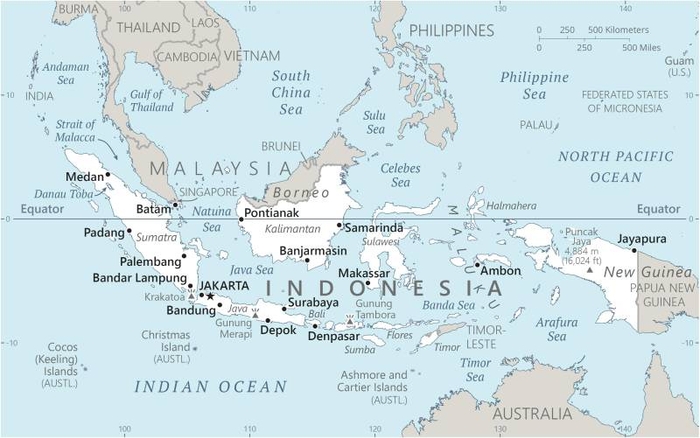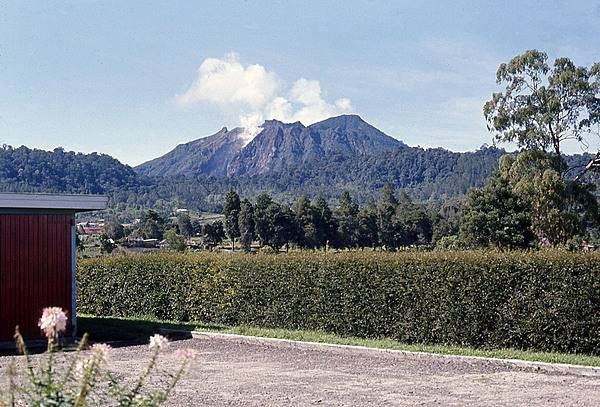141 Indonesia

Two equal horizontal bands of red (top) and white. The colors derive from the banner of the Majapahit Empire of the 13th-15th centuries. Red symbolizes courage, white represents purity.
Flag courtesy of the CIA World Factbook

Map courtesy of the CIA World Factbook

Indonesia is tectonically highly unstable, making it the site of numerous volcanoes and frequent earthquakes. The archipelago lies on the Pacific Ring of Fire where the Indo-Australian Plate and the Pacific Plate are pushed under the Eurasian plate and where they melt at about 100 km (62 mi) below the earths’ surface. A string of volcanoes runs southeastward through Sumatra, Java, Bali, and Nusa Tenggara, and then fishhooks north and westward to the Banda Islands of Maluku and North Sulawesi. Of the 400 or so Indonesian volcanoes, around 130 are active. The photo shows a dormant but smoking volcano on the island of Sumatra.
Photo courtesy of the CIA World Factbook
Government
According to Britannica, the Republic of Indonesia was declared in 1945, with a proclaimed jurisdiction over the present area from Sabang in Sumatra to Merauke in Papua, or the entire area of the former Dutch (or Netherlands) East Indies. Although the Netherlands retained possession of a large part of this region (including Papua), a provisional capital was established in Yogyakarta, the stronghold of the revolution.
With the close of the struggle for independence in 1949, the Republic of the United States of Indonesia was established. The federal system did not last, however, and in 1950 the federated governments unanimously decided to return to a “unitary”, or more centralized, form of government, as well as to the name Republic of Indonesia. After some difficulties, the constitution of 1945 was reinstated by presidential decree. This constitution has remained the basis of Indonesia’s government, although some significant amendments were made during a period of reformasi (reformation) around the turn of the 21st century.
The 1945 constitution invests most of the power in the executive branch of the government, particularly in the president, who is assisted by a vice president and a cabinet. The constitution also provides for a body of presidential advisers, called the Supreme Advisory Council (Dewan Pertimbangan Agung) the advice of which is not legally binding, however, as well as a presidentially appointed Supreme Audit Board (Badan Pemeriksa Keuangan), which controls state finance. Until 2002 the president and vice president were elected every five years by the People’s Consultative Assembly (Majelis Permusyawaratan Rakyat; MPR), but in that year a new law decreed that beginning in 2004 both leaders were to be directly elected. In addition, legislation passed in 1999 limited the president to two five-year terms.
Cabinet ministers are appointed by the president. Ministries manage broad areas, such as economic affairs, foreign affairs, defense, education, agriculture, information, and religious affairs. The number of ministers and the nature of their areas of assignment depend on the president. In addition to appointing the cabinet, the president is the supreme commander of the army, the navy, and the air force. The president also has the authority to introduce bills, issue regulations, implement acts, and make agreements with foreign countries.
The MPR constitutes the legislative branch of Indonesia’s government; it is primarily responsible for interpreting the constitution and the broad lines of state policy. Formerly unicameral, the MPR has been a bicameral body since the elections of 2004, with the Council of the People’s Representatives (Dewan Perwakilan Rakyat; DPR) as the lower house and the Council of Regional Representatives (Dewan Perwakilan Daerah; DPD) as the upper house. About four-fifths of the MPR’s seats belong to the lower house. Members of the DPD are elected directly from a nationwide pool of nonpartisan candidates, and members of the DPR are directly elected through a province-based proportional system that allows voters to cast ballots for individuals as well as particular parties. All legislators serve five-year terms.
Indonesia is divided into some 30 propinsi, or provinsi (provinces), plus the two daerah istimewa (special districts) of Yogyakarta in central Java and Aceh in northern Sumatra and the daerah khusus ibukota (special capital district) of metropolitan Jakarta, known as Jakarta Raya. On the smaller islands, most administrative regions were created to coincide with traditional regions, the boundaries of which were defined largely by natural geographic features; on the larger islands, by contrast, administrative boundaries were constructed to simplify complex traditional and cultural divisions. The province of Central Java (Jawa Tengah), for instance, spans not only the core of the island of Java but also the core of Javanese culture. Within the province’s borders lie the semiautonomous special district of Yogyakarta and the city of Surakarta (Solo), both of which are historical court centers that maintain traditional rulers (albeit without real political power). Similarly, the provinces of West Java (Jawa Barat) and Banten, on the western part of the island, coincide with the geographic, cultural, and linguistic terrain of the Sundanese people.
The number of first-order political subdivisions has changed since the end of the 20th century. East Timor (declared a province in 1976) gained its independence in 1999. In addition, largely as a result of the push to decentralize in the early 21st century, several new provinces were created out of the existing structure. The province of Banten (2000) was formed from the western tip of West Java. West Papua (Papua Barat; 2006) was created from the western end of Papua. North Kalimantan (Kalimantan Utara; 2012) was split off from East Kalimantan. New provinces in Celebes included Gorontalo (2000; government installed in 2001) on the northern peninsula and West Sulawesi (Sulawesi Barat; 2004) in the island’s west-central coastal region. The Riau Islands (Kepulauan Riau; 2002; government installed in 2004) and Bangka Belitung (2000; government installed in 2001) were created from islands off Sumatra’s eastern shore.
Each of the more than 300 second-order subdivisions, kabupaten (regencies), is headed by a bupati (governor) and has a local legislature. More than 5,000 third-order divisions, kecamatan (districts), and several dozen kota (cities) have obtained autonomous status. Since 1999 district and city leaders have been chosen through direct local elections. Members of the Local Councils of Representatives (Dewan Perwakilan Rakyat Daerah), which deal more directly with the national legislature, also are selected through general election.
Villages (kampung) and groups of villages (desa), which exist in both rural and urban areas, provide the link between the people and the central government on the district level. Kampung and desa heads are usually elected in rural areas and appointed in urban ones; they are all local government employees. Normally, a village has two levels of neighborhood organization, a rukun warga (RW; community association) and rukun tetangga (RT; neighborhood associations). These bodies elect their chairpersons.
In Indonesia’s judicial system the Supreme Court (Mahkamah Agung) in Jakarta is the final court of appeal; high courts, which are located in principal cities, deal with appeals from district courts. Supreme Court judges are chosen by the president, who selects from nominees presented by the Judicial Commission, a special body whose members are appointed by the upper house. The chief justice and his or her deputies are chosen from among the Supreme Court justices by the justices themselves. According to the original 1945 constitution, the Supreme Court does not have the power of judicial review. In 2003, however, the Constitutional Court (Mahkamah Konstitusi) was established to review and to rule on cases involving charges against the president. Judges are members of the civil service and are managed by the Supreme Court, but they also are supervised by the Judicial Commission. The National Ombudsman Commission, established in 2000, deals with offenses committed by the state.
Under the colonial administration, the law was a mixture of Dutch law and local customary law, adat. Since independence, criminal law has been codified for all of Indonesia. Civil law, however, has continued to be based largely on adat, which varies from one region and ethnic group to another. There are four judicial spheres (for general, religious, military, and administrative matters), each with its own courts. The religious, military, and administrative courts deal with special cases or particular groups of people, while the general courts handle both civil and criminal cases. Muslims may choose to use Islamic law in some civil cases; since the mid-1970s religious law has applied to all civil matters dealing with marriage.
Directorate General of Civil Aviation
In accordance with the Regulation of the Minister of Transportation Number 122 of 2018 concerning the Organization and Administration of the Ministry of Transportation, the Secretariat of the Directorate General of Civil Aviation has the task of coordinating the implementation of tasks and providing technical and administrative support services to all organizational units within the Directorate General of Civil Aviation.
Airspace
SkyVector – Google Maps – ADS-B Exchange
ICAO countries publish an Aeronautical Information Publication (AIP). This document is divided into three parts: General (GEN), En Route (ENR) and Aerodromes (AD). ENR 1.4 details the types of airspace classes they chose to adopt from classes A through G.
Indonesia AIP – requires login
AirNav Indonesia
AirNav Indonesia – The Aeronautical Information Center has the main task and function of organizing Aeronautical Information services throughout the working area of the Indonesian Aviation Navigation Service Provider Agency, including the management of aeronautical information products in the form of Aeronautical Information Publication (AIP) Amendment, AIP Supplement, NOTAM, ASHTAM, AIC (Aeronautical Information Circular) and Flight Maps, publication and dissemination of NOTAM and ASHTAM, as well as flight procedure designs.
Drone Regulations
SMALL UNMANNED AIRCRAFT SYSTEM – 2021 Rule
Advanced Air Mobility (AAM) Regulations & Policies
Bilateral agreements facilitate the reciprocal airworthiness certification of civil aeronautical products imported/exported between two signatory countries. A Bilateral Airworthiness Agreement (BAA) or Bilateral Aviation Safety Agreement (BASA) with Implementation Procedures for Airworthiness (IPA) provides for airworthiness technical cooperation between the FAA and its counterpart civil aviation authorities.
Bilateral Airworthiness Agreement
Schedule of Implementation Procedures
Revised Export Documentation Requirement For Engines And Propellers
2016 Notification of Policy Deviation Memorandum for FAA Order 8130.21H
Obtaining Certification Approval from this Country
Advanced Air Mobility (AAM) News
2025 – Indonesian Helicopter Group Plans eVTOL Air-taxi Services
2025 – EH216-S eVTOL aircraft carries 1st Indonesian passengers
2025 – Indonesian company joins Archer Midnight launch program
2024 – VELA ALPHA EVTOL COULD BE INDONESIA’S FIRST NEW CIVIL AIRCRAFT IN DECADES
Short Essay Questions
Scenario-Based Question
You have been hired by a Drone Startup Company. Your boss has immediately assigned this job to you.
They need you to prepare a one-page memo detailing the legalities of using a drone to film the Borobudur Temple Compounds in Indonesia.
They need you to mention any national laws and local ordinances.
They specifically want to know what airspace (insert pictures) you will be operating in and whether or not you need an airspace authorization.
Does it matter whether or not you are a citizen of the country?
Lastly, there is a bonus for you if, as you scroll through this chapter, you find any typos or broken links!
Short Essay Questions
- What are the drone categories?
- How is registration addressed?
- How is remote ID addressed?
- What are the model aircraft rules?
- What are the commercial drone rules?
- Are there waivers or exemptions to the rules? If so, for what?
- Would you share a link to an interactive airspace map?
- How is BVLOS addressed?
- How can you fly drones at night?
- How can you fly drones over people?
- Where do you find drone NOTAMs?
- What are the rules for drone maintenance?
- What are the rules for an SMS program?
- What are some unique rules not mentioned above?
- What are the C-UAS rules?
- What are the AAM rules?

